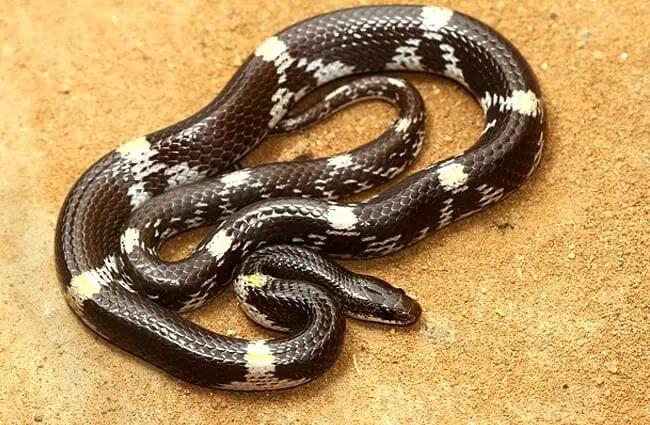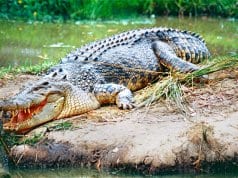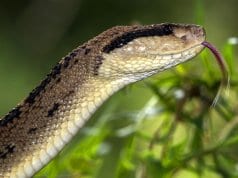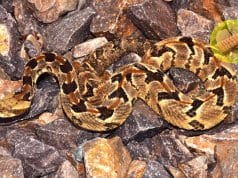The world of snakes is filled with fascinating creatures, and among them the wolf snake stands out as a particularly intriguing species. Often mistaken for aggressive vipers due to its defensive display, this non venomous snake is a master of disguise and adaptation. This comprehensive guide delves into the life history, behavior, and ecological role of wolf snakes, offering insights for both the casual observer and the dedicated researcher.

What is a Wolf Snake?
Wolf snakes belong to the genus Lycodon, a group of colubrid snakes found across Africa and Asia. The name “wolf snake” originates from their peculiar habit of exposing their teeth when threatened, resembling a snarling wolf. Despite their intimidating display these snakes are entirely harmless to humans, possessing no venom and relying on camouflage and swift movement to evade predators. There are several species of wolf snakes, each adapted to its specific geographic location and ecological niche.
Identification
Wolf snakes are typically slender, with smooth scales and a coloration ranging from brown to grey, often with darker bands or blotches. These patterns aid in camouflage, blending them into leaf litter, undergrowth, and rocky environments. Adults usually reach lengths of 30 to 60 centimeters, though some species can grow larger. A key identifying feature is their relatively large eyes and rounded pupils, a characteristic that distinguishes them from venomous snakes that often have elliptical pupils.
Habitat and Distribution
Wolf snakes exhibit a broad geographic distribution, inhabiting a variety of ecosystems across Africa and Asia. They are commonly found in tropical and subtropical forests, grasslands, shrublands, and even urban areas. Their adaptability allows them to thrive in diverse environments, from dense jungles to rocky outcrops and agricultural lands. Specific species have varying ranges. For example, the common wolf snake (Lycodon aulicus) is widespread throughout India, Southeast Asia, and parts of Indonesia, while the Cape wolf snake (Lycodon capensis) is native to southern Africa.

Diet and Hunting Strategy
Wolf snakes are primarily nocturnal hunters, feeding on small vertebrates and invertebrates. Their diet consists largely of lizards, frogs, insects, and occasionally small rodents or bird eggs. They may constrict briefly but rely mostly on swallowing their prey alive. Their hunting strategy often involves ambushing prey from concealed positions, utilizing their camouflage to remain undetected.
Finding Prey
These snakes use a combination of scent and vision to locate prey. They can detect subtle vibrations in the ground, alerting them to the presence of nearby animals. Once prey is located, they strike quickly and accurately, securing a firm grip with their teeth before initiating constriction.
Reproduction and Life Cycle
Wolf snakes are oviparous, meaning they reproduce by laying eggs. Mating typically occurs during the warmer months, and females lay a clutch of 5 to 20 eggs in a concealed location, such as under rocks, logs, or in leaf litter. The eggs incubate for approximately 60 to 90 days, depending on the species and environmental conditions. Hatchlings are miniature versions of the adults and are immediately independent, relying on their instincts to hunt and evade predators. The life expectancy of wolf snakes in the wild is estimated to be between 5 and 10 years, though they may live longer in captivity with proper care.

Ecological Role and Interactions
Wolf snakes play an important role in maintaining the balance of their ecosystems. As predators of small vertebrates and invertebrates they help control populations of these animals. They also serve as prey for larger predators such as birds of prey, mammals, and other snakes, contributing to the food web. Their presence indicates a healthy ecosystem, as they require a diverse range of prey and suitable habitat to thrive. They often coexist with other snake species, sharing resources and contributing to the overall biodiversity of their environment.
Interactions with Humans
Due to their non venomous nature and secretive behavior, wolf snakes rarely pose a threat to humans. However, they are sometimes mistaken for venomous snakes, leading to unnecessary fear and persecution. In some cultures they are believed to have medicinal properties or are used in traditional ceremonies. Their presence in agricultural areas can be beneficial, as they help control populations of rodents and other pests. However, they may also be perceived as a nuisance if they enter homes or gardens.
Wolf Snakes in Culture
In various cultures across Africa and Asia, wolf snakes hold symbolic significance. Some communities revere them as guardians of forests or protectors of crops. Their unique appearance and behavior have inspired folklore, mythology, and artistic representations. In certain regions they are associated with good luck or prosperity, while in others they are believed to possess supernatural powers. These cultural beliefs highlight the deep connection between humans and the natural world.

Identifying and Encountering Wolf Snakes in the Wild
For those interested in observing wolf snakes in their natural habitat, understanding their preferred environments and behaviors is crucial. They are most active during the night or at dusk, often found hiding under rocks, logs, or leaf litter. Look for them in areas with dense vegetation, near water sources, or in rocky outcrops. When encountering a wolf snake it is important to remain calm and avoid sudden movements. Do not attempt to handle or provoke the snake, as this may cause it to bite in self defense. Observe it from a safe distance and appreciate its beauty and ecological importance.
What to do if you encounter a Wolf Snake?
- Remain calm and avoid sudden movements.
- Give the snake plenty of space.
- Do not attempt to handle or provoke it.
- Observe it from a safe distance.
- Report any sightings to local wildlife authorities.
Caring for Wolf Snakes in Captivity
Keeping wolf snakes as pets requires specialized knowledge and commitment. They need a secure enclosure with appropriate temperature, humidity, and lighting. The enclosure should be large enough to allow for movement and exploration, and it should be furnished with hiding places, climbing branches, and a water source. Wolf snakes require a diet of appropriately sized prey such as lizards, frogs, or rodents. Regular cleaning and maintenance of the enclosure are essential to prevent disease and ensure the snake’s well-being. It is important to consult with a veterinarian specializing in reptiles to ensure the snake receives proper care.

Evolutionary History
The evolutionary history of wolf snakes, like many colubrids, is still being investigated. However, molecular data suggests the genus Lycodon diverged from other colubrid lineages during the late Cretaceous or early Paleogene periods. The distribution of current species suggests a possible origin in Asia, with subsequent dispersal into Africa. The evolution of their wolf like defensive display is believed to be a form of Batesian mimicry, where a harmless species evolves to resemble a dangerous one, deterring potential predators. The specific adaptations of each species reflect the unique environmental pressures and ecological niches they occupy.
The world of the wolf snake is a testament to the remarkable diversity and adaptability of life on Earth. These fascinating creatures play a vital role in maintaining the health and balance of ecosystems, and their unique characteristics continue to captivate scientists and nature enthusiasts alike. By understanding and appreciating these often overlooked reptiles we can contribute to their conservation and ensure their survival for generations to come.






![Red Angus Closeup of a beautiful Red Angus cowPhoto by: U.S. Department of Agriculture [pubic domain]https://creativecommons.org/licenses/by/2.0/](https://animals.net/wp-content/uploads/2020/03/Red-Angus-4-100x75.jpg)

